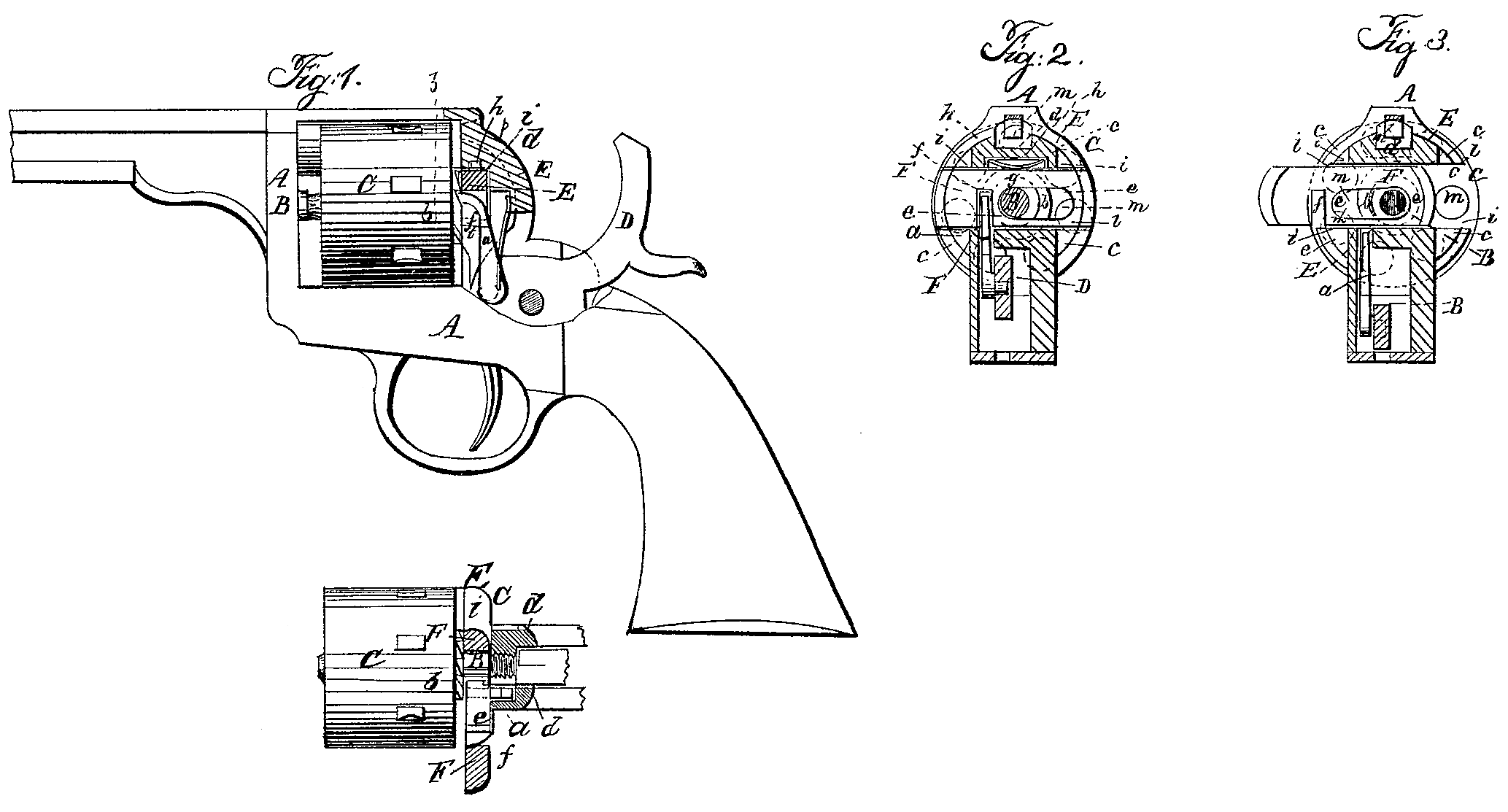US 37075
UNITED STATES PATENT OFFICE.
JAMES JENKINSON, OF BROOKLYN, ASSIGNOR TO JOSEPH MERWIN AND E. P. BRAY, OF NEW YORK, N.Y.
IMPROVEMENT IN REVOLVING FIRE-ARMS.
Specification forming part of Letters Patent No. 37,075, dated December 2, 1862.
To all whom it may concern:
Beit known that I, James Jenkinson, of the city of Brooklyn, in the county of Kings and State of New York, have invented a new and useful Improvement in Revolving Fire-Arms; and I do hereby declare that the following is a full, clear, and exact description of the same, reference being had to the accompanying drawings, forming part of this specification, in which—
Figure 1 is a side view, partly in section, of a pistol with my improvement. Figs. 2 and 3 are transverse sections of the same in rear of the recoil-shield, exhibiting it in two different conditions. Fig. 4 is a horizontal section of the cylinder and frame.
Similar letters of reference indicate corresponding parts in the Several figures.
This invention relates to that class of revolving fire-arms in which the bores of the chambers are continued right through the cylinder for loading them at the breech with metallic cartridges.
It consists in so constructing a slide for closing the opening provided in the recoil-shield for the insertion of the cartridges into the chambers, and so applying the same in combination with the pawl by which the rotary motion of the cylinder is produced, that the said slide prevents the acts of cocking the hammer or rotating the cylinder while it is open, and that the hammer, when cocked, prevents the said slide from being opened.
To enable others skilled in the art to make and use my invention, I will proceed to describe its construction and operation.
A E is the frame, made of one piece, and having the cylinder C secured in it by an axis-pin, B, which is applied and confined to its place in any suitable manner.
D is the hammer, having attached to it at the right-hand side a pawl, a, which operates in the usual manner upon a ratchet-wheel, b b, formed upon or secured to the cylinder, for the purpose of producing the rotation of the latter.
F is the slide which constitutes my invention, made with its edges of dovetail form, as shown in Fig. 1, and fitted to a groove, i i, of corresponding form, which is provided across the front of the recoil-shield E for its reception. This groove is of a depth equal to the thickness of the side portions or cheeks, c c, of the recoil-shield, so that it forms an opening in each cheek-piece, and is only closed at its back in the thicker central portion, d, of the recoil-shield. This slide has provided in it a slot, e, for the passage of the cylinder axis-pin, the said slot being long enough to allow the said slide a sufficient longitudinal movement to withdraw it from the open portion of the slot i i on the right-hand side of the recoil-shield, as shown in Fig. 3, for the purpose of permitting the loading of the chambers m m of the cylinder, and to return it for the purpose of closing the said portion of the slot, as shown in Fig. 2. The said slide has also a deep notch, f, in its lower edge, for the pawl a to work through when the said slide is in the closed condition shown in Fig. 2. The slide is to be moved with the thumb and finger; but to prevent it from being moved too freely a spring, g, is applied within a recess, h, in the upper part of the groove ii, such spring pressing on the upper edge of the slide and producing sufficient friction thereon for the purpose.
The pawl a is of such length and so arranged relatively to the slide F that its point is below the bottom of the slide, as shown in Fig. 3, while the hammer is not drawn back beyond the position of half-cock, and hence it permits . the free movement of the slide when the hammer is down or at the position of half-cock. Another consequence of this arrangement of the pawl a is that while the slide is open and its notch f is not opposite the pawl any attempt to cock the hammer is prevented by the point of the pawl being stopped by coming in contact with the bottom of the slide, and this also prevents the rotation of the cylinder from being produced. When the slide is closed the notch f, being opposite the pawl, permits the latter to pass into it and so pass through the slide into the ratchet-wheel b, and permits the rotation of the cylinder, as well as the cocking of the hammer, to be produced, and while the pawl is in the said notch it effectually prevents the slide from being moved longitudinally, and hence keeps it locked while the hammer is cocked.
What I claim as my invention, and desire to secure by Letters Patent, is—
The slide F, so constructed with a slot, e, and notch f, or their equivalents, and so combined with the pawl a, through which the rotation of the cylinder is effected, that the cocking of the hammer and rotation of the cylinder are prevented while the slide is open, and that the pawl prevents the slide from being opened while the hammer is being cocked, substantially as herein specified.
JAMES JENKINSON.
Witnesses:
R, Gawley,
J. W. Coombs.

